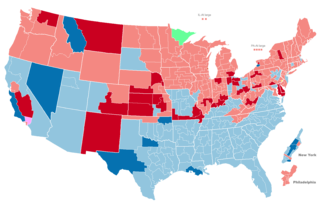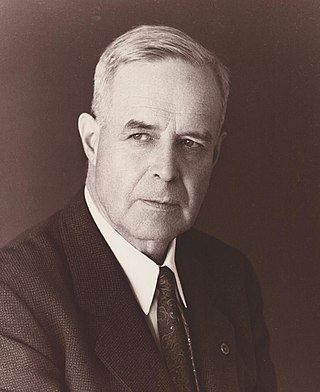
The 1922 United States Senate elections were elections that occurred in the middle of Republican President Warren G. Harding's term. The 32 seats of Class 1 were contested in regular elections, and special elections were held to fill vacancies. With the Republicans divided between conservative and progressive factions, the Democrats gained six net seats from the Republicans while the Farmer–Labor party gained one. The Republicans retained their Senate majority.

The 1920 United States Senate elections were elections for the United States Senate that coincided with the presidential election of Warren G. Harding. The 32 seats of Class 3 were contested in regular elections, and special elections were held to fill vacancies. Democrat Woodrow Wilson's unpopularity allowed Republicans to win races across the country, winning ten seats from the Democrats and providing them with an overwhelming 59-to-37 majority. The Republican landslide was so vast that Democrats lost over half of the contested seats this year and failed to win a single race outside the South. In fact, this is the most recent occasion where every race decided by under 10 points all voted for the same party, showcasing the sheer strength of Republicans' performance in this election.

The 1920 United States House of Representatives elections were elections for the United States House of Representatives to elect members to serve in the 67th United States Congress. They were held for the most part on November 2, 1920, while Maine held its on September 13. They coincided with the election of President Warren G. Harding, the first time that women in all states were allowed to vote in federal elections after the passage of the 19th Amendment.

The 1918 United States House of Representatives elections were elections for the United States House of Representatives to elect members to serve in the 66th United States Congress. They were held for the most part on November 5, 1918, while Maine held theirs on September 9. They occurred in the middle of President Woodrow Wilson's second term.

The 67th United States Congress was a meeting of the legislative branch of the United States federal government, consisting of the United States Senate and the United States House of Representatives. It met in Washington, D.C., from March 4, 1921, to March 4, 1923, during the first two years of Warren Harding's presidency. The apportionment of seats in the House of Representatives was based on the 1910 United States census.

Donegal is a parliamentary constituency which has been represented in Dáil Éireann, the lower house of the Irish parliament or Oireachtas, since the 2016 general election. The constituency elects five deputies on the system of proportional representation by means of the single transferable vote (PR-STV).
The 1921 Penistone by-election was a by-election held on 5 March 1921 for the British House of Commons constituency of Penistone in Yorkshire.
Patea is a former New Zealand electorate in south Taranaki. It existed from 1893 to 1963.
The 1921 Dudley by-election was held on 3 March 1921. The by-election was held due to the appointment of the incumbent Coalition Conservative MP, Arthur Griffith-Boscawen, as Minister of Agriculture and Fisheries. It was won by the Labour candidate James Wilson. It was one of only eight ministerial by-elections in the UK to not be retained by the incumbent.
Elections were held in the state of Western Australia on 12 March 1921 to elect all 50 members to the Legislative Assembly. The incumbent government, led by Premier James Mitchell of the Nationalist Party and supported by the Country Party and National Labor Party, won a second term in government against the Labor Party opposition, led by Opposition Leader Philip Collier.
The Patea by-election was a by-election in the New Zealand electorate of Patea, a rural seat on the west coast of the North Island.
Elections to Liverpool City Council were held on 1 November 1921.

The 1921 San Diego mayoral election was held on April 5, 1921, to elect the mayor for San Diego. In the primary election, former mayor James E. Wadham and former City Councilmember John L. Bacon received the most votes and advanced to the runoff. Bacon was then elected mayor with a majority of the votes.

An election was held on March 20, 1923, to elect the mayor for San Diego. Incumbent mayor John L. Bacon stood for reelection. In the primary election, Bacon received a majority of the votes and was elected outright with no need for a contested runoff.

There was a single special election in 1921 to the United States Senate. It was held in New Mexico for the Class 2 seat, previously held by Albert B. Fall, who resigned March 3, 1921 to become U.S. Secretary of the Interior. Holm O. Bursum was appointed March 11, 1921 to replace him until this special election. On September 20, 1921 he also won the election.

United States gubernatorial elections were held in 1921, in two states.
Events in the year 1921 in Belgium.

The 1920 New Mexico gubernatorial election was held on November 2, 1920.
I Riigikogu was the first legislature of the Estonian Parliament (Riigikogu). The legislature was elected after 1920 elections. It sat between 20 December 1920 and 30 May 1923, before the next round of elections were held.
Albert Kariyawasam was a Sri Lankan politician.











